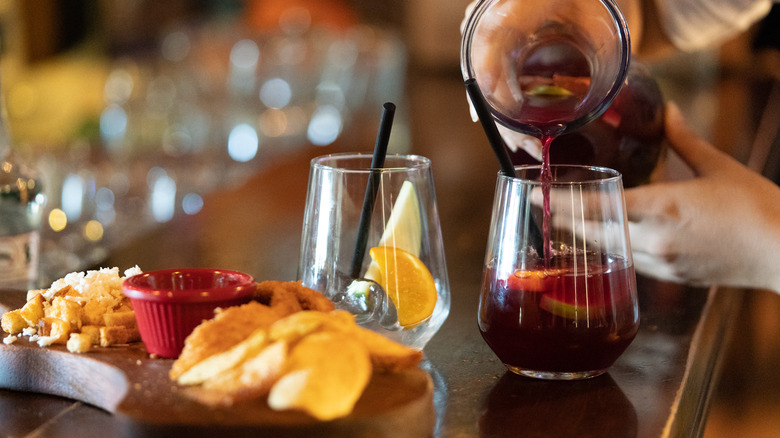The Unexpected Reasons Tourists Should Just Avoid Ordering Sangria In Spain
It's sort of a given to indulge in Parisian croissants when in France and handmade lasagna al ragú when in Italy. Similarly, ordering a glass of sangria the second you step off the plane in Spain might be your first instinct, but you may want to think again. Contrary to popular belief, sangria is anything but the local staple in Spain. This refreshing, cocktail is traditionally made with red wine, macerated fruit, and spices, but many restaurants and bars have begun putting their own spin on sangria, adding syrup, brandy, liqueurs, soda, or juice.
The origins of sangria are deeply rooted in Spanish history, with some of the earliest drinks concocted by ancient Roman settlers traversing Spain's Iberian peninsula. It was here that they experimented with an early version that more closely resembled mulled wine and is believed to have provided the foundation for sangria. It wasn't until the 15th century that Spaniards began preparing sangria, often using red wine from the Rioja region.
However, it's rare to glimpse locals sipping on sangrias at Spanish bars, and it may indicate the bar is a tourist trap to avoid. Comparable to a glass of punch or inexpensive wine you'd find in other regions of the world, sangria is rarely served at the dinner table and more commonly reserved for special occasions. But to cater to tourists, some bars offer sangria on the menu and use alternative ingredients, resulting in a less-than-authentic version of traditional sangria.
Skip the sangria in Spain
Sangria may be rooted in Spanish culture, but America's bar scene popularized this iconic fruity cocktail beverage. It became a cultural sensation in the United States in 1964 when Spain's pavilion promoted the beverage at the World's Fair in New York City. It wasn't long after that locals deemed sangria a staple in bars across the country.
Given the flavors from the macerated fruit and added juice, soda, and liqueurs, the result is often quite sweet. Spaniards rarely indulge in sweet drinks at dinner, making it difficult for sangrias to fit in with a meal. Tapas bars and taverns with English-translated menus in tourist centers are often the ones serving sangria to thirsty visitors looking for a refreshing summer cocktail. It's also common to spot this drink at trendy beach bars and resorts along the coast of Spain, given sangria's beachy cocktail nature.
Because of its popularity among tourists, sangria tends to be overpriced and is rarely worth the pretty penny it costs in Spain. The best authentic sangria requires time and patience, something not easy to come by. Allowing the fruit to macerate and flavor the wine results in the most robust notes, but is difficult to achieve in the fast-paced bars found across Spain.
Pass the tinto de verano, please
Unlike Americans, who have happily embraced this sugary cocktail since its introduction in 1964, Spaniards prefer the "local version" of sangria, known as tinto de verano. While unfamiliar to most tourists, it's the drink of choice among most natives in Spain. This popular cocktail translates to "summer red" and is made from a simple blend of red wine and lemon soda. With less alcohol, easier assembly, and a cheaper price tag, it's not hard to see why tinto de verano has essentially replaced sangria among locals in Spain. Should you come across a menu offering "sangria", it's often an elaborate imitation of the popular tinto de verano drink. Bartenders will often add some pre-cut fruit to pass it off as an authentic sangria — not ideal for visitors hoping to immerse themselves in Spanish culture.
While tinto de verano is a local's go-to when heading out for drinks, there are plenty of other options besides sangria to satisfy your cocktail craving. Found mostly across sandy beach bars and the coastal streets of Spain, kalimotxo combines red wine with Coca-Cola for a sweet and sticky cocktail refresher. Always a budget-friendly option on Spanish menus, it's popular among younger age groups and is often the drink of choice at parties. Alternatively, orxata is a frothy delight made from tiger nuts. Soaked overnight in water and then blended with sugar, the result is a milkshake-like consistency that's perfect for beating the heat on those scorching summer days.


